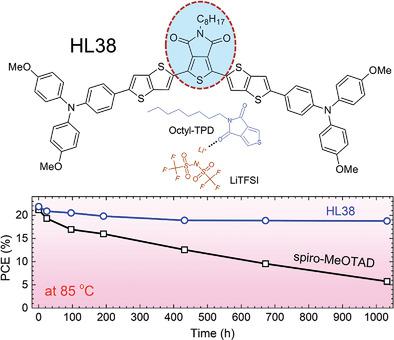当前位置:
X-MOL 学术
›
Adv. Mater.
›
论文详情
Our official English website, www.x-mol.net, welcomes your
feedback! (Note: you will need to create a separate account there.)
Capturing Mobile Lithium Ions in a Molecular Hole Transporter Enhances the Thermal Stability of Perovskite Solar Cells
Advanced Materials ( IF 27.4 ) Pub Date : 2021-02-19 , DOI: 10.1002/adma.202007431 Seul‐Gi Kim 1 , Thi Huong Le 2 , Thybault Monfreid 2 , Fabrice Goubard 2 , Thanh‐Tuân Bui 2 , Nam‐Gyu Park 1
Advanced Materials ( IF 27.4 ) Pub Date : 2021-02-19 , DOI: 10.1002/adma.202007431 Seul‐Gi Kim 1 , Thi Huong Le 2 , Thybault Monfreid 2 , Fabrice Goubard 2 , Thanh‐Tuân Bui 2 , Nam‐Gyu Park 1
Affiliation

|
A thermally stable perovskite solar cell (PSC) based on a new molecular hole transporter (MHT) of 1,3‐bis(5‐(4‐(bis(4‐methoxyphenyl) amino)phenyl)thieno[3,2‐b]thiophen‐2‐yl)‐5‐octyl‐4H‐thieno[3,4‐c]pyrrole‐4,6(5H)‐dione (coded HL38) is reported. Hole mobility of 1.36 × 10−3 cm2 V−1 s−1 and glass transition temperature of 92.2 °C are determined for the HL38 doped with lithium bis(trifluoromethanesulfonyl)imide and 4‐tert‐butylpyridine as additives. Interface engineering with 2‐(2‐aminoethyl)thiophene hydroiodide (2‐TEAI) between the perovskite and the HL38 improves the power conversion efficiency (PCE) from 19.60% (untreated) to 21.98%, and this champion PCE is even higher than that of the additive‐containing 2,2′,7,7′‐tetrakis(N,N‐di‐p‐methoxyphenylamine)‐9,9′‐spirobifluorene (spiro‐MeOTAD)‐based device (21.15%). Thermal stability testing at 85 °C for over 1000 h shows that the HL38‐based PSC retains 85.9% of the initial PCE, while the spiro‐MeOTAD‐based PSC degrades unrecoverably from 21.1% to 5.8%. Time‐of‐flight secondary‐ion mass spectrometry studies combined with Fourier transform infrared spectroscopy reveal that HL38 shows lower lithium ion diffusivity than spiro‐MeOTAD due to a strong complexation of the Li+ with HL38, which is responsible for the higher degree of thermal stability. This work delivers an important message that capturing mobile Li+ in a hole‐transporting layer is critical in designing novel MHTs for improving the thermal stability of PSCs. In addition, it also highlights the impact of interface design on non‐conventional MHTs.
中文翻译:

在分子空穴传输剂中捕获移动锂离子可增强钙钛矿太阳能电池的热稳定性
一种热稳定的钙钛矿太阳能电池(PSC),基于新的1,3-双(5-(4-(双(4-(4-(甲氧基苯基)氨基)苯基))噻吩[3,2-b])分子空穴传输剂(MHT)据报道有噻吩-2-基)-5-辛基-4H-噻吩并[3,4-c]吡咯-4,6(5H)-二酮(编码HL38)。对于掺有双(三氟甲磺酰基)酰亚胺锂和4-叔丁基的HL38,确定的空穴迁移率为1.36×10 -3 cm 2 V -1 s -1,玻璃化转变温度为92.2°C丁基吡啶作为添加剂。在钙钛矿和HL38之间进行2-(2-氨基乙基)噻吩氢碘化物(2-TEAI)的界面工程将功率转换效率(PCE)从19.60%(未经处理)提高到21.98%,该冠军PCE甚至更高2,2'含添加剂的,7,7'-四(ñ,ñ -二p-甲氧基苯胺)-9,9'-螺二芴(spiro-MeOTAD)装置(21.15%)。在85°C下进行了1000多个小时的热稳定性测试表明,基于HL38的PSC保留了初始PCE的85.9%,而基于spiro-MeOTAD的PSC则从21.1%降至5.8%,无法恢复。飞行时间二次离子质谱研究与傅立叶变换红外光谱结合发现,由于Li +与HL38的强络合作用,HL38的锂离子扩散率低于spiro- MeOTAD,这是导致较高热度的原因。稳定。这项工作传达了一条重要信息,那就是捕获移动Li +在设计新颖的MHT来改善PSC的热稳定性时,空穴传输层中的关键是至关重要的。此外,它还强调了界面设计对非常规MHT的影响。
更新日期:2021-03-23
中文翻译:

在分子空穴传输剂中捕获移动锂离子可增强钙钛矿太阳能电池的热稳定性
一种热稳定的钙钛矿太阳能电池(PSC),基于新的1,3-双(5-(4-(双(4-(4-(甲氧基苯基)氨基)苯基))噻吩[3,2-b])分子空穴传输剂(MHT)据报道有噻吩-2-基)-5-辛基-4H-噻吩并[3,4-c]吡咯-4,6(5H)-二酮(编码HL38)。对于掺有双(三氟甲磺酰基)酰亚胺锂和4-叔丁基的HL38,确定的空穴迁移率为1.36×10 -3 cm 2 V -1 s -1,玻璃化转变温度为92.2°C丁基吡啶作为添加剂。在钙钛矿和HL38之间进行2-(2-氨基乙基)噻吩氢碘化物(2-TEAI)的界面工程将功率转换效率(PCE)从19.60%(未经处理)提高到21.98%,该冠军PCE甚至更高2,2'含添加剂的,7,7'-四(ñ,ñ -二p-甲氧基苯胺)-9,9'-螺二芴(spiro-MeOTAD)装置(21.15%)。在85°C下进行了1000多个小时的热稳定性测试表明,基于HL38的PSC保留了初始PCE的85.9%,而基于spiro-MeOTAD的PSC则从21.1%降至5.8%,无法恢复。飞行时间二次离子质谱研究与傅立叶变换红外光谱结合发现,由于Li +与HL38的强络合作用,HL38的锂离子扩散率低于spiro- MeOTAD,这是导致较高热度的原因。稳定。这项工作传达了一条重要信息,那就是捕获移动Li +在设计新颖的MHT来改善PSC的热稳定性时,空穴传输层中的关键是至关重要的。此外,它还强调了界面设计对非常规MHT的影响。











































 京公网安备 11010802027423号
京公网安备 11010802027423号